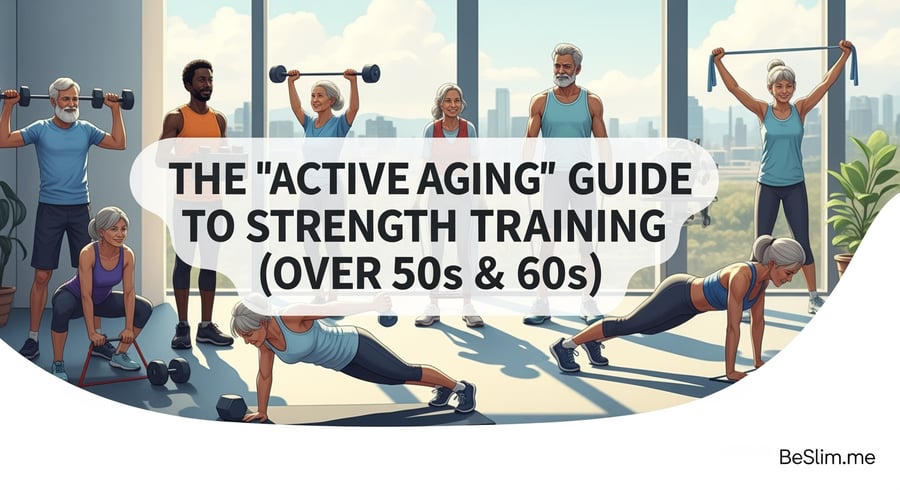Hey there, champions of vitality! I'm Master Kim, your Certified Personal Trainer (CPT) and Biomechanics Specialist at BeSlim.me. If you're over 50 or cruising into your 60s, you might think strength training is for the young guns at the gym. Think again! This guide is your ticket to "Active Aging," where we harness the power of strength training to build resilience, boost energy, and keep you moving like a well-oiled machine. Strength training isn't just about lifting heavy—it's about smart, safe moves that enhance your quality of life. We'll dive into the science, prioritize safety (because that's non-negotiable), and give you a practical 30-minute routine you can do at home or the gym. Let's get you stronger, safer, and more confident—one rep at a time!
In this guide, we'll cover why strength training is a game-changer for folks over 50, backed by science. You'll get a beginner-friendly routine with detailed form cues to protect your joints, plus tips on progressing without overdoing it. Remember, consistency beats intensity every time. If you have any health concerns, chat with your doctor before starting. Ready to age actively? Let's lift!
Why Strength Training Matters Over 50
As we hit our 50s and 60s, our bodies naturally experience changes like muscle loss (sarcopenia), reduced bone density, and a slower metabolism. But here's the exciting part: strength training can reverse or slow these down! It's not about bulking up like a bodybuilder; it's about functional strength that helps with everyday tasks—carrying groceries, climbing stairs, or playing with grandkids.
Strength training builds muscle mass, which supports joint health and improves balance, reducing fall risks. It also enhances mental well-being by releasing endorphins and boosting confidence. Plus, it's a metabolism booster—more muscle means you burn more calories even at rest. We'll explore the science next, but first, a quick actionable takeaway: Start with bodyweight exercises and progress slowly. Aim for 2-3 sessions per week, and always listen to your body.
The Science Behind Strength Training Over 50 and Metabolism
Let's geek out on the "why" behind this. Strength training is a powerhouse for metabolic health, especially as we age. When you engage in resistance exercises, your muscles undergo microscopic tears that repair stronger, leading to increased muscle mass. This process, known as hypertrophy, directly impacts your basal metabolic rate (BMR)—the calories your body burns at rest.
Research shows that adults over 50 can gain significant muscle and strength through consistent training, countering age-related decline. For instance, strength training helps preserve muscle mass and boosts metabolism in older adults, according to a study from the National Institutes of Health (NIH). This is crucial because after 50, we lose about 1-2% of muscle mass per year, which slows metabolism and increases fat storage. By building muscle, you ramp up your BMR, making it easier to maintain a healthy weight.
Metabolically, strength training improves insulin sensitivity, helping regulate blood sugar and reducing risks of type 2 diabetes. It also stimulates hormone production, like growth hormone and testosterone, which naturally dip with age. A key physiological benefit is enhanced mitochondrial function in muscle cells—these are your energy powerhouses. Better mitochondria mean more efficient fat burning, even during low-activity periods.
On the fat loss front, combining strength training with cardio (like walking) creates a synergistic effect. Muscle tissue is metabolically active, burning more calories than fat. For example, gaining just a few pounds of muscle can increase daily calorie burn by 50-100 calories. Science backs this: resistance training increases resting metabolic rate in aging populations, as detailed in PubMed research. This isn't just theory—it's practical for "active aging," helping you stay lean and energetic.
Beyond metabolism, it strengthens bones by increasing density, combating osteoporosis. Joints benefit too, as stronger muscles provide better support and reduce strain. In short, strength training rewires your body for efficiency, turning back the clock on aging. Actionable takeaway: Focus on compound movements (like squats) that work multiple muscles for maximum metabolic impact.
Safety First: Essential Warnings and Form Instructions
Before we jump into the routine, safety is my top priority. As a biomechanics specialist, I always emphasize proper form to protect your joints, back, and overall well-being. If you're new to this or have conditions like arthritis or osteoporosis, consult a doctor first. Start slow, use light weights (or none at all), and stop if you feel pain (not to be confused with normal muscle fatigue).
Mandatory Safety Warnings and Form Checks for Beginners
- Consult a Professional: Get cleared by your healthcare provider, especially if you have heart issues, joint problems, or recent injuries.
- Warm-Up Always: Spend 5 minutes marching in place or doing arm circles to increase blood flow and reduce injury risk.
- Breathing Technique: Exhale on the effort (e.g., when lifting) and inhale on the release. Never hold your breath.
- Core Engagement: Keep your core tight—like bracing for a punch—to stabilize your spine and protect your back.
- Joint Alignment: Maintain neutral spine (no arching or rounding); knees should track over toes in lower-body moves.
- Modify as Needed: If an exercise feels off, drop to a easier variation (e.g., wall sits instead of squats).
- Rest and Recover: Take 60-90 seconds between sets; hydrate and don't train if you're overly fatigued.
- Listen to Your Body: Pain in joints or sharp discomfort? Stop immediately. Aim for controlled movements, not speed.
Remember, form trumps everything—poor technique can lead to setbacks. If you're unsure, film yourself or work with a trainer. Safety ensures longevity in your fitness journey!
Your 30-Minute Workout Routine
This routine is designed for 2-3 sessions per week, totaling about 30 minutes including warm-up and cool-down. It's suitable for home (using bodyweight or household items like water bottles) or gym settings. We'll focus on full-body strength to maximize efficiency and metabolism boost. Each exercise includes science-backed benefits: they build muscle to elevate BMR, improve bone density, and enhance daily function.
Perform a 5-minute warm-up (light walking or dynamic stretches), then cycle through the exercises with minimal rest. Cool down with gentle stretches. Start at beginner level and progress as you build confidence.
1. Chair Squats
- Sets x Reps: 3 sets of 10-12 reps
- Key Form Cue / Technical Focus: Keep your chest up and knees tracking over toes; lower until thighs are parallel to the ground, using a chair for support if needed.
- Difficulty Level: Beginner
- Why It Works: This targets quads, glutes, and core, building lower-body strength that supports metabolism by increasing muscle mass in large groups.
2. Wall Push-Ups
- Sets x Reps: 3 sets of 8-10 reps
- Key Form Cue / Technical Focus: Place hands shoulder-width on the wall; lower your chest toward it while keeping elbows at 45 degrees from your body.
- Difficulty Level: Beginner
- Why It Works: Strengthens chest, shoulders, and triceps, which helps maintain upper-body function and boosts overall calorie burn through compound movement.
3. Seated Rows (with Resistance Band or Towel)
- Sets x Reps: 3 sets of 10-12 reps per side
- Key Form Cue / Technical Focus: Sit tall with band around feet; pull elbows back, squeezing shoulder blades together without shrugging.
- Difficulty Level: Beginner/Intermediate
- Why It Works: Targets back muscles, improving posture and countering desk-related slouch, while enhancing metabolic rate via back muscle activation.
4. Bird-Dog Holds
- Sets x Reps: 3 sets of 20-30 seconds per side
- Key Form Cue / Technical Focus: On all fours, extend opposite arm and leg while keeping hips level and core engaged to avoid back sway.
- Difficulty Level: Beginner
- Why It Works: Builds core stability and balance, crucial for fall prevention, and supports metabolism by engaging deep stabilizers.
5. Standing Calf Raises
- Sets x Reps: 3 sets of 12-15 reps
- Key Form Cue / Technical Focus: Hold onto a wall for balance; rise onto toes slowly, focusing on a full heel drop for ankle mobility.
- Difficulty Level: Beginner
- Why It Works: Strengthens calves and improves lower-leg circulation, aiding in overall mobility and subtle metabolic gains.
6. Overhead Press (with Light Dumbbells or Bottles)
- Sets x Reps: 3 sets of 8-10 reps
- Key Form Cue / Technical Focus: Press weights overhead from shoulder height, keeping core tight and avoiding arching your back.
- Difficulty Level: Intermediate
- Why It Works: Works shoulders and arms, enhancing upper-body strength that contributes to higher BMR through muscle building.
7. Plank on Knees
- Sets x Reps: 3 sets of 20-30 seconds
- Key Form Cue / Technical Focus: From knees, hold body in a straight line with forearms on the ground; engage core without letting hips sag.
- Difficulty Level: Beginner
- Why It Works: Core-focused for spinal support, which indirectly boosts metabolism by improving posture and efficiency in other exercises. Core strengthening reduces injury risk in older adults, per Mayo Clinic guidelines.
Total time: Warm-up (5 min) + routine (20 min) + cool-down (5 min). These exercises are low-impact, emphasizing control to protect joints while building strength.
Progression Plan: Building Strength Over 4-8 Weeks
Progression is key to avoiding plateaus and ensuring safe gains. Start with the beginner versions above for Weeks 1-2, focusing on perfect form. Track your sessions in a journal—note how you feel and any improvements.
- Weeks 1-2: Foundation Building – Stick to the listed sets/reps. Add 1-2 extra reps if it feels easy, but prioritize form. Aim for consistency; rest days are for recovery.
- Weeks 3-4: Increase Intensity – Bump reps to 12-15 or add a fourth set. Introduce light weights (e.g., 5-10 lb dumbbells) for squats and presses if bodyweight feels too easy.
- Weeks 5-6: Add Variations – Progress to intermediate levels, like full push-ups from knees or longer holds. Increase time for planks to 45 seconds.
- Weeks 7-8: Advanced Tweaks – Incorporate pauses (e.g., 2-second hold at the bottom of squats) or combine with light cardio intervals. Reassess: If you're stronger, cycle back or add a new exercise like step-ups.
Monitor progress by how daily tasks feel easier. If you hit a snag, drop back a level—progress isn't linear. Science supports gradual increases: Steady progression prevents overuse injuries while maximizing muscle adaptations. Actionable takeaway: Adjust based on energy levels, and celebrate small wins like better balance!
Tips for Success and Long-Term Active Aging
To make this stick, integrate it into your routine. Pair with nutrition—focus on protein-rich meals to fuel muscle repair. Stay hydrated, get 7-9 hours of sleep, and consider mobility work like yoga on off days. Common pitfalls? Rushing progression or ignoring form—avoid them for sustainable results.
Motivation boost: You're not just training muscles; you're investing in independence. Studies show strength training correlates with longer, healthier lives. Keep it fun—play upbeat music or train with a buddy. If joint issues arise, modifications like seated versions keep you going.
In closing, this guide empowers you to embrace strength training safely. As Master Kim, I'm cheering you on— you've got this! Start today, and watch your energy soar.
References
Medical Disclaimer
The content on this website is for informational and educational purposes only. It is not intended as medical advice and should not be relied upon as a substitute for consultations with qualified healthcare professionals who are familiar with your individual medical needs. Always seek the advice of your physician or other qualified healthcare provider with any questions you may have regarding a medical condition. Never disregard professional medical advice or delay in seeking it because of something you have read on this website.





Comments (0)
No comments yet. Be the first to comment!